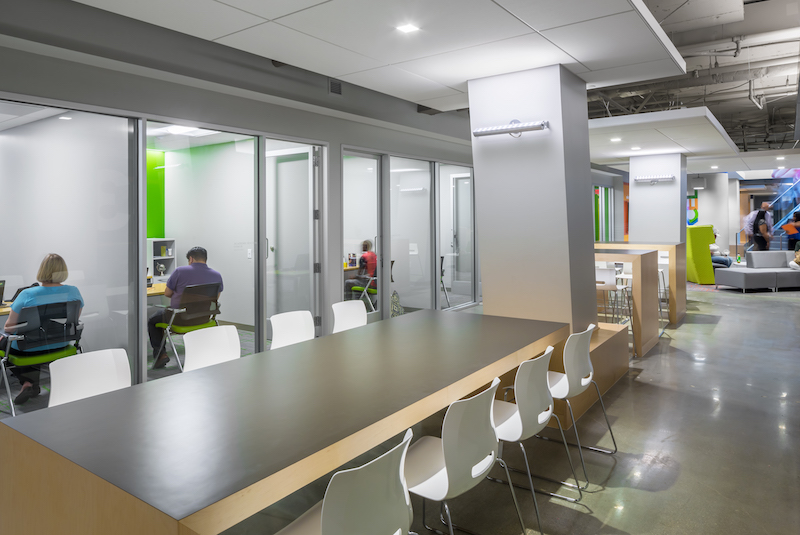About 63,000 adults in Washington D.C.—10% of the area’s adult population—lack high school diplomas. And these are the adults whom the Goodwill Excel Center, this market’s first adult charter high school, hopes to bring back to the educational fold.
Goodwill Industries of Greater Washington opened its first Excel Center in August inside a two-level, 21,500-sf basement space on G Street near the Old Executive Building. Goodwill received 2,055 applications for the 325 seats available. Three quarters of the students in its first class are women, and the ages of the students range from 26 to 39 years old. Seventy percent live in Wards 7 and 8, among D.C.’s poorest.
The D.C. school models itself after the first Excel Center in Indianapolis, which opened in 2010. There are now 11 Excel Centers in central Indiana, as well as in Memphis, Austin, Little Rock, Ark., and South Bend, Ind.
Catherine Meloy, CEO of Goodwill of Greater Washington, says her branch saw the need for an Excel Center after learning that many of the 2,000 applicants for jobs at D.C.’s Marriott Marquis hotel were turned away because their hadn’t graduated from high school. Several others who had a diploma weren’t hired because they couldn’t pass Marriott’s reading and math tests.
The Goodwill Excel Center operates five eight-week terms annually, and estimates it will take most students about two years to complete their education and earn a diploma. Meloy says that some of curricula are dual credited with a local college, and graduates will be credentialed in one of five industries: hospitality, security, healthcare, technology, or energy/utilities.
Beth Buffington, NCARB, LEED AP BD+C, Studio Principal with Little Community Group—which provided interior architecture, sustainable design, and brand communication and design services—recalls that the space Goodwill found for its first Excel Center left a lot to be desired.
“We referred to it as the ‘Minotaur Space,’ ” she says. “The carpets and walls were brown, some of the columns were sloping. It was a tired location. We wanted it to be more open and transparent.”
Little upgraded the artificial lighting, and managed to bring in some natural light, too. It made the finishes lighter, and injected “a hip, business look,” says Buffington, which opened up the walls and ceilings of the basement. Classrooms and learning areas support collaboration. And the layout allows teachers and mentors to be visible and accessible to the students at all times.
The school offers childcare services. And Little worked in graphics and biophilia that sup port Goodwill’s mission to the community.
The Goodwill Excel Center is tuition free, and city’s Office for School Education provides per-pupil financing, a percentage of which helped pay for the renovation. Goodwill Industries kicked in some money, and the group worked with a D.C.-based REIT to get a tenant allowance. The school also has corporate sponsors that include Capitol One and SunTrust.
Meloy says the goal is to have five Excel Centers in the D.C. area, and expects the second school to open by 2018. “The first was meant to be replicable so there would be branding and a consistent color tone,” she says.
Related Stories
| May 18, 2011
Major Trends in University Residence Halls
They’re not ‘dorms’ anymore. Today’s collegiate housing facilities are lively, state-of-the-art, and green—and a growing sector for Building Teams to explore.
| May 18, 2011
Former Bronx railyard redeveloped as shared education campus
Four schools find strength in numbers at the new 2,310-student Mott Haven Campus in New York City. The schools—three high schools and a K-4 elementary school—coexist on the 6.5-acre South Bronx campus, which was once a railyard.
| May 18, 2011
Eco-friendly San Antonio school combines history and sustainability
The 113,000-sf Rolling Meadows Elementary School in San Antonio is the Judson Independent School District’s first sustainable facility, with green features such as vented roofs for rainwater collection and regionally sourced materials.
| May 18, 2011
New Reform Jewish Independent school opens outside Boston
The Rashi School, one of only 17 Reform Jewish independent schools in North American and Israel, opened a new $30 million facility on a 166-acre campus shared with the Hebrew SeniorLife community on the Charles River in Dedham, Mass.
| May 18, 2011
Addition provides new school for pre-K and special-needs kids outside Chicago
Perkins+Will, Chicago, designed the Early Learning Center, a $9 million, 37,000-sf addition to Barrington Middle School in Barrington, Ill., to create an easily accessible and safe learning environment for pre-kindergarten and special-needs students.
| May 18, 2011
Raphael Viñoly’s serpentine-shaped building snakes up San Francisco hillside
The hillside location for the Ray and Dagmar Dolby Regeneration Medicine building at the University of California, San Francisco, presented a challenge to the Building Team of Raphael Viñoly, SmithGroup, DPR Construction, and Forell/Elsesser Engineers. The 660-foot-long serpentine-shaped building sits on a structural framework 40 to 70 feet off the ground to accommodate the hillside’s steep 60-degree slope.
| May 18, 2011
One of Delaware’s largest high schools seeks LEED for Schools designation
The $82 million, 280,000-sf Dover (Del.) High School will have capacity for 1,800 students and feature a 900-seat theater, a 2,500-seat gymnasium, and a 5,000-seat football stadium.

















